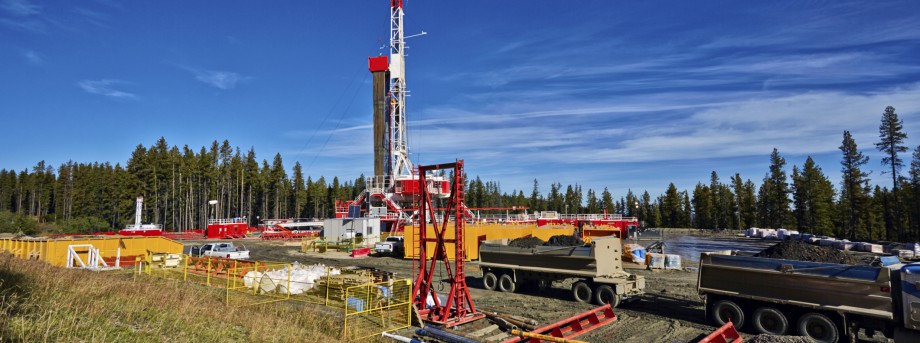The University of Nottingham
 Exchange online
Exchange online
Research Exchange
Engineers develop an early warning system to make fracking safer

November 3 2014
New technology developed by researchers at The University of Nottingham could offer an early warning system to signpost any potential risks to land stability associated with fracking.
Shale gas extraction close to hidden fractures beneath the earth’s surface is associated with an increase in earthquakes. The new surveying software can provide a detailed picture of where these fault lines lie with millimetre accuracy.
The software — dubbed PUNNET GEO — could assist local authorities and operating companies in making a more informed decision about which areas may be suitable for fracking, while offering greater reassurance to the public who may fear damage caused by gas extraction-related ground tremors.
It was recently recognised with a major international award, picking up the overall prize at the Copernicus Masters Earth Monitoring Competition. There are now plans to develop the innovation for the international market through the formation of a new spin-out company.
Dr Andrew Sowter, in the University’s Department of Civil Engineering, has developed the software and is working in collaboration with the University’s GNSS Research Applications Centre of Excellence (GRACE).
Dr Sowter said: “To discover that a small achievement in research has tangible commercial value is really the ultimate accolade in Engineering. Winning the Copernicus Masters has been a huge boost for the PUNNET GEO system and we are now fully committed to unlocking the economic, environmental and social potential of our innovation
The new development builds on existing technology that allows engineers to use satellite radar technology to measure points on the landscape over a length of time to assess whether they are moving up (uplifting) or sinking down (subsiding).
Previously, this has relied on using fixed, unchanging objects like buildings that can be accurately re-measured and compared against previous measurements time after time. However, the technique has not been practical for use in the rural landscape meaning that geologists could only get half the picture.
Dr Sowter’s technique called the Intermittent Small Baseline Subset (ISBAS) method adapts the same technology and extends it to rural areas by taking stacks of these radar images and identifying those more transient points in the rural landscape against which changes over time are able to be measured.
Shale gas has the potential to help Europe reach its long-term carbon emissions target and to reduce its overreliance on a market dominated by the Middle East, Russia and Ukraine.
However, the extraction of the gas from shale rock, known as fracking, has been associated with earth tremors both in the UK – notably in Blackpool on 2011 – and in other parts of the world including Canada and the US.
The quakes are believed to be caused by the high pressure injection of water as part of the fracking process which is triggering fault lines beneath the surface and causing movement.
PUNNET GEO allows surveyors to develop a detailed map of land movement over a large region and importantly to identify where fault lines which may be associated with seismic activity are located.
Not only could it be useful for local authorities deciding whether to grant licenses for fracking in their region, but could also help operating companies to identify areas which may be problematic before drilling starts. US studies indicate it costs companies up to £5 million per reservoir when something goes wrong.
The new software could replace existing exploratory methods which are ground-based, invasive, time consuming and expensive.
It could also help to provide information to allay public concerns and support insurance cover and claims.
The software is already being used by the British Geological Survey (BGS), based in Keyworth in Nottinghamshire, which is the world’s oldest national geological survey providing expert services and impartial advice on all areas of geosciences for both the public and private sectors. The BGS is playing a role in the research project by validating the testing the software.
PUNNET GEO won the overall prize at the Copernicus Masters Competition, which awards prizes to innovative solutions for business and society based on Earth observation data. This was in addition to being recognised as winner of the individual Radar Constellation Challenge Category in the awards.
Paul Bhatia, General Manager of GRACE said: “We are really thrilled at winning the Copernicus Masters. This is a great step forward for the PUNNET GEO system and The University of Nottingham. It provides great recognition of the value that satellite applications can provide to the economy as well as the environment.”
This year, the prize pool had a total value of €300,000 including cash prizes, technical support, data packages, and business incubation.
As overall winner – the Copernicus Master – the University team was selected from the winners of all Challenges (except for the winner of the Best Service Challenge) and was awarded an additional cash prize of €20,000. Moreover, the project will benefit from a substantial satellite data quota worth €60,000 made available with financial support by the European Commission.
Tags: British Geological Survey, Copernicus Masters Earth Monitoring Competition, Department of Civil Engineering, Dr Andrew Sowter, early warning system, earthquakes, fracking, GNSS Research Applications Centre of Excellence, Intermittent Small Baseline Subset method, land stability, PUNNET GEO, research, Shale gas extraction
Leave a Reply
Other

Top prize for quantum physicist
A University of Nottingham physicist has won a prestigious medal from the Institute of Physics for […]

Zero carbon HOUSE designed and built by students comes home
Design and construct a low cost, zero carbon, family starter home, transport it to Spain, build […]